
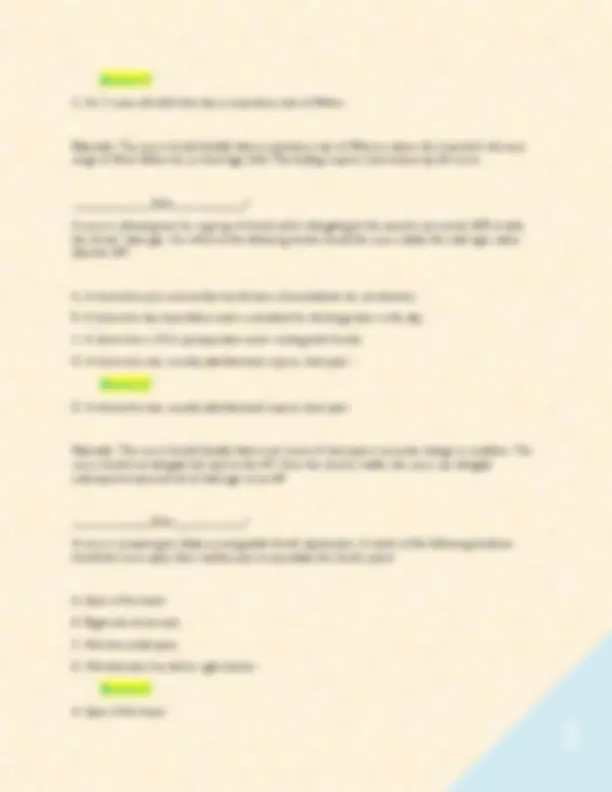
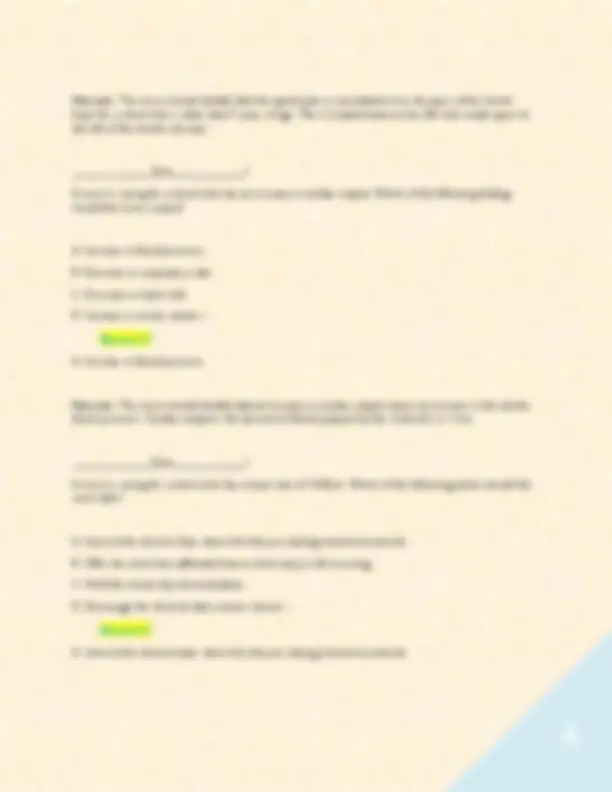
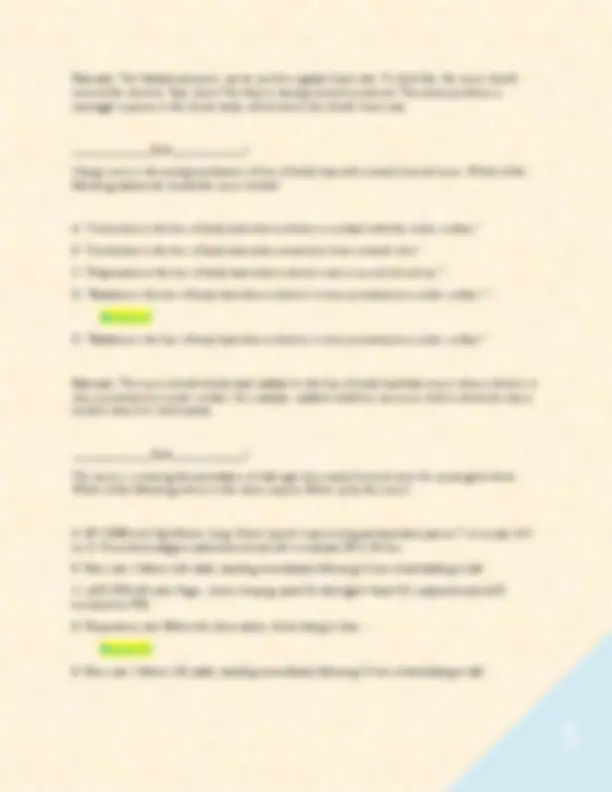
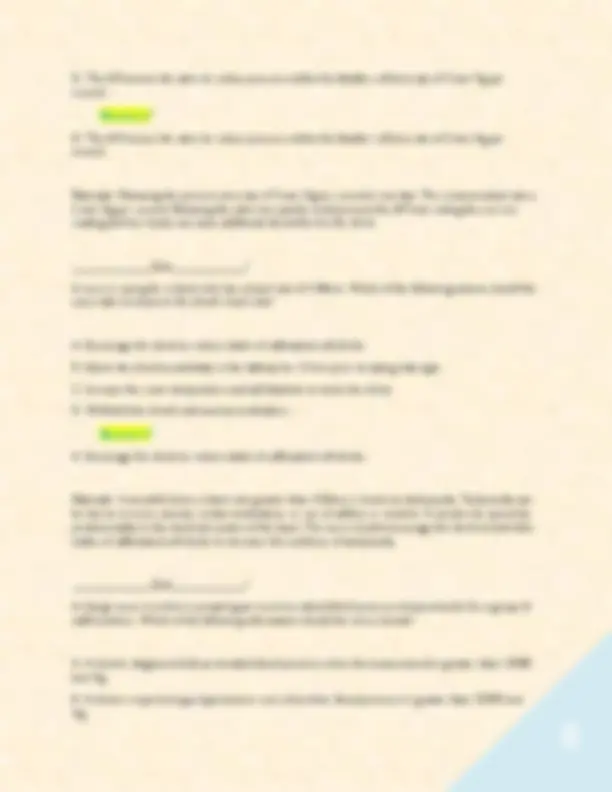
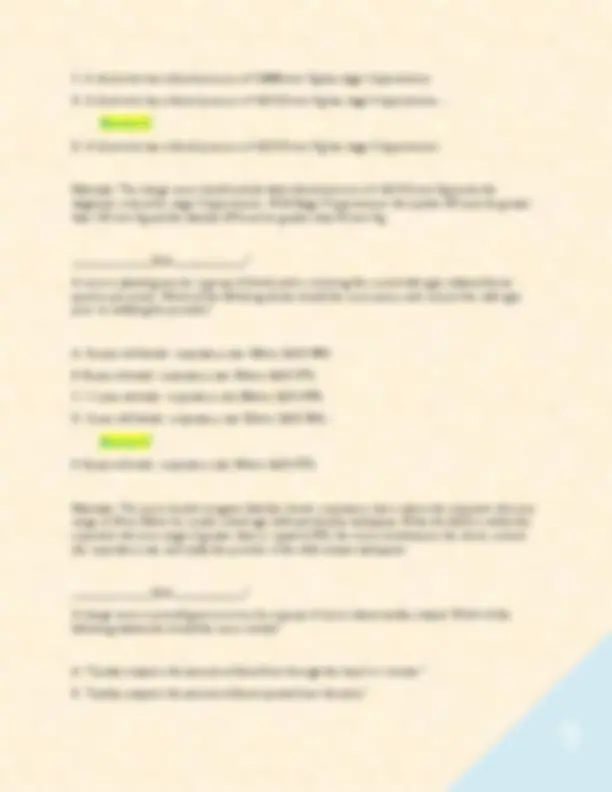
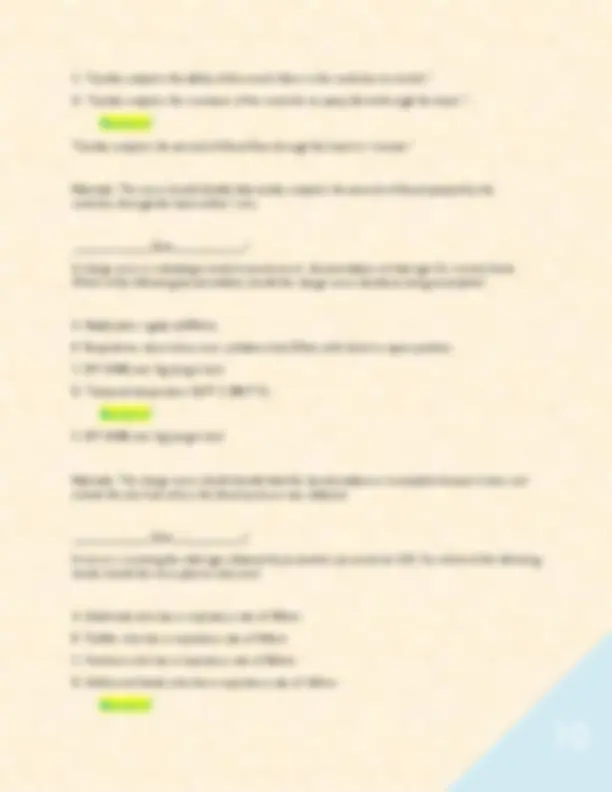
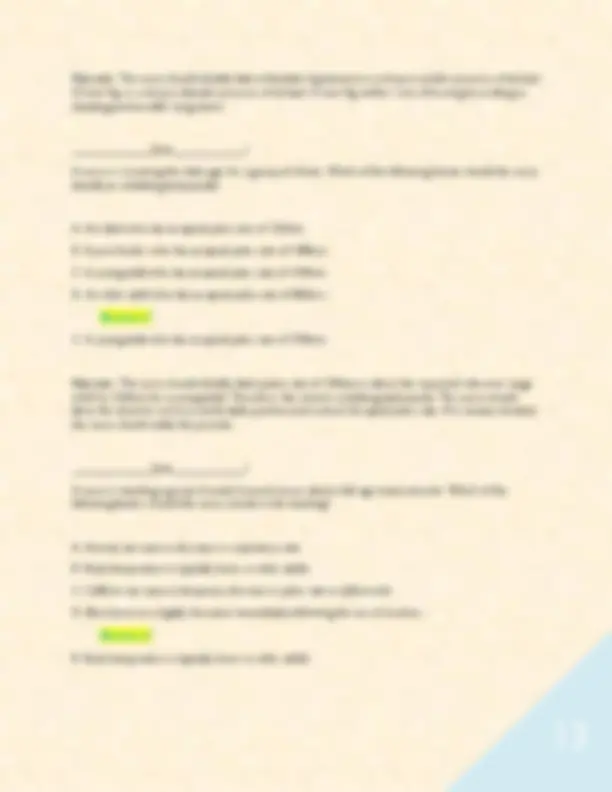
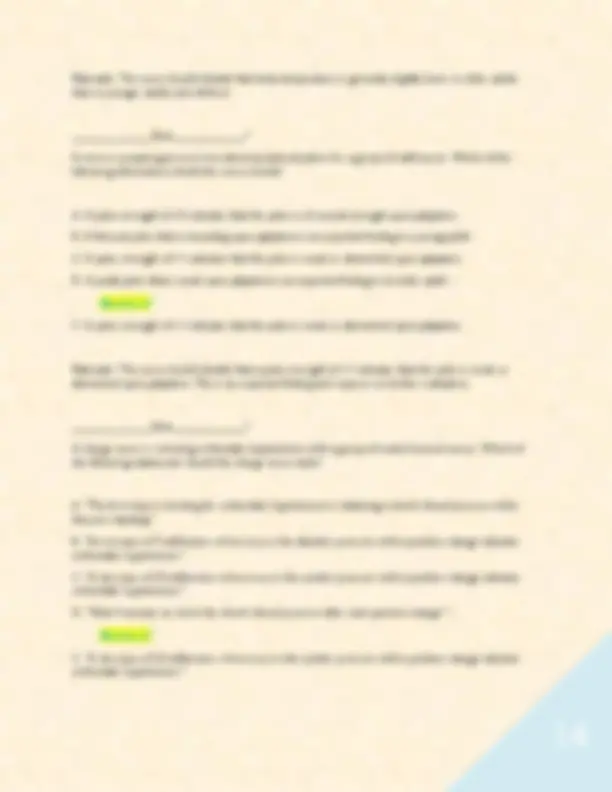
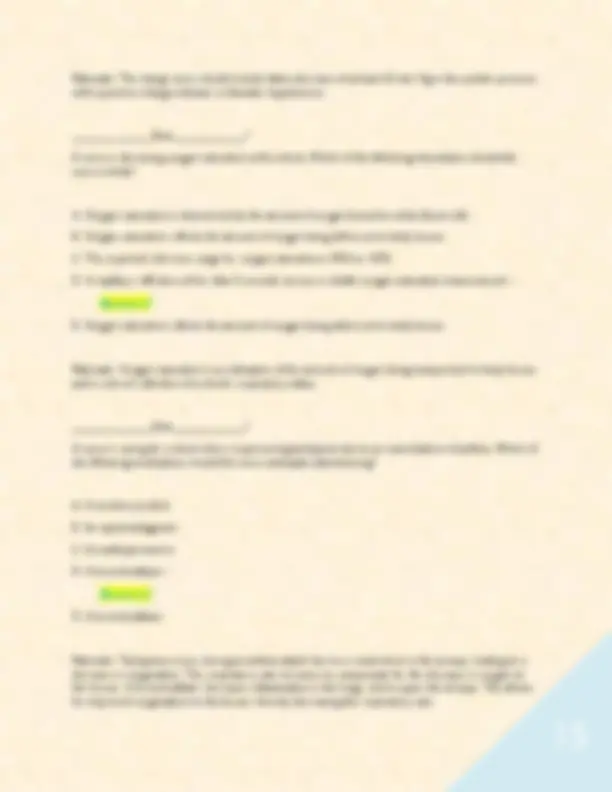
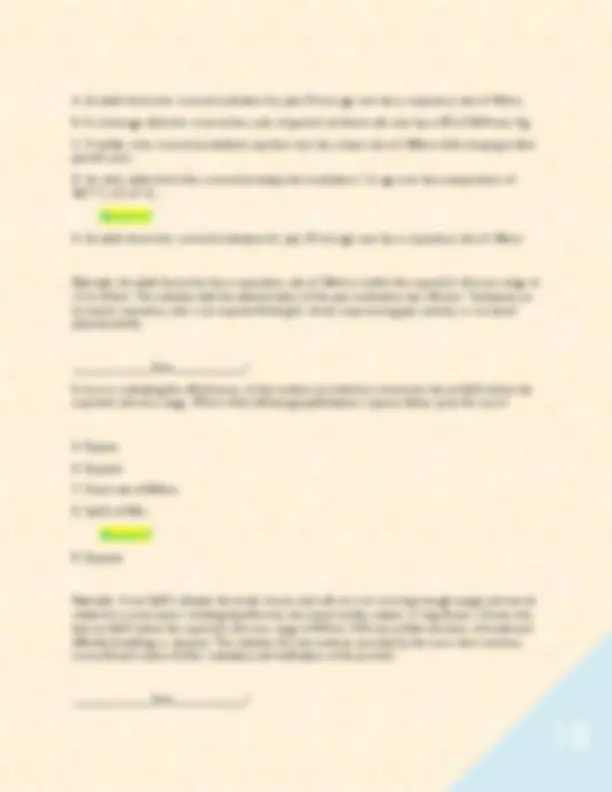
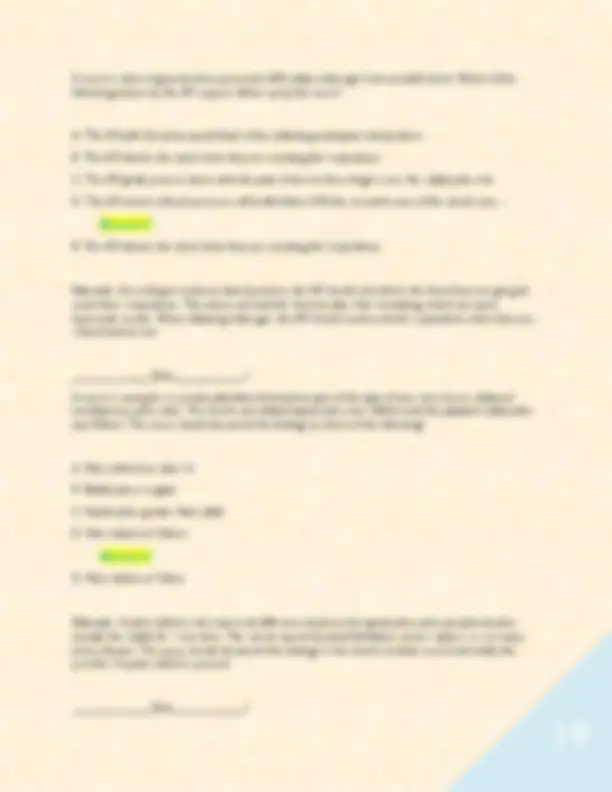
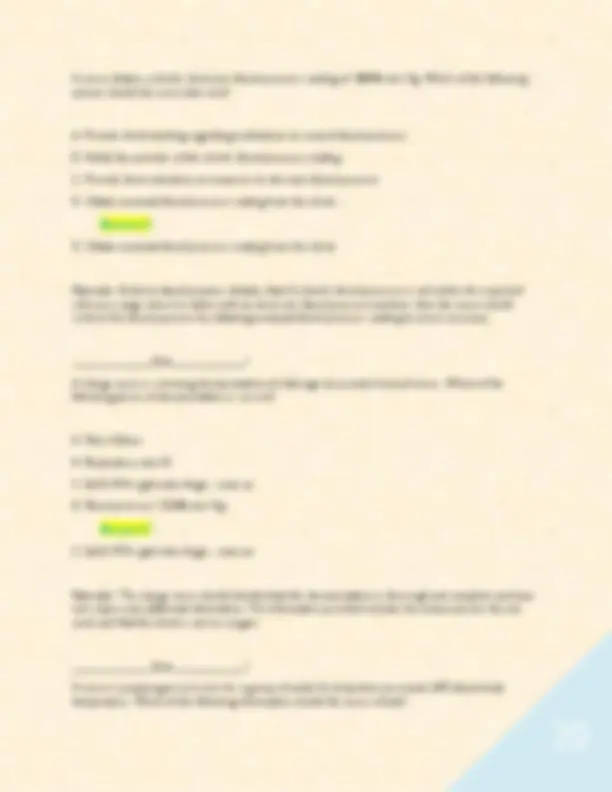
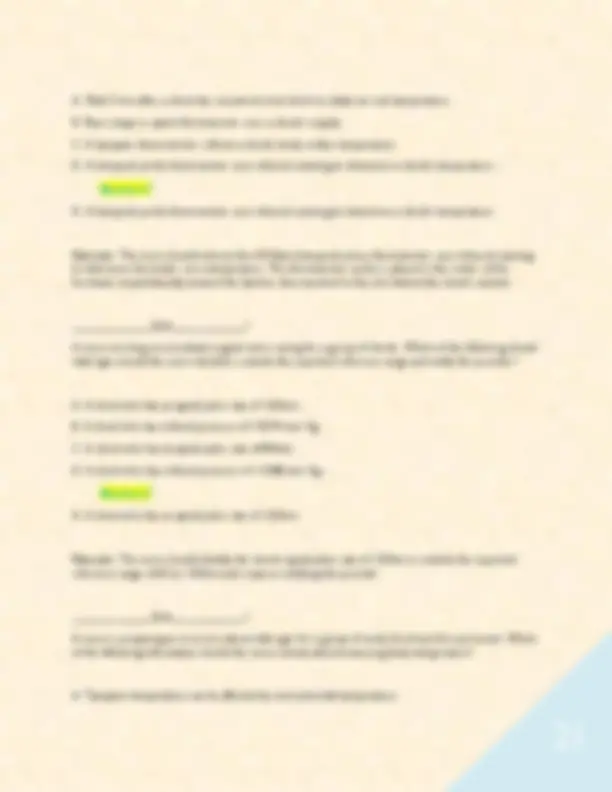
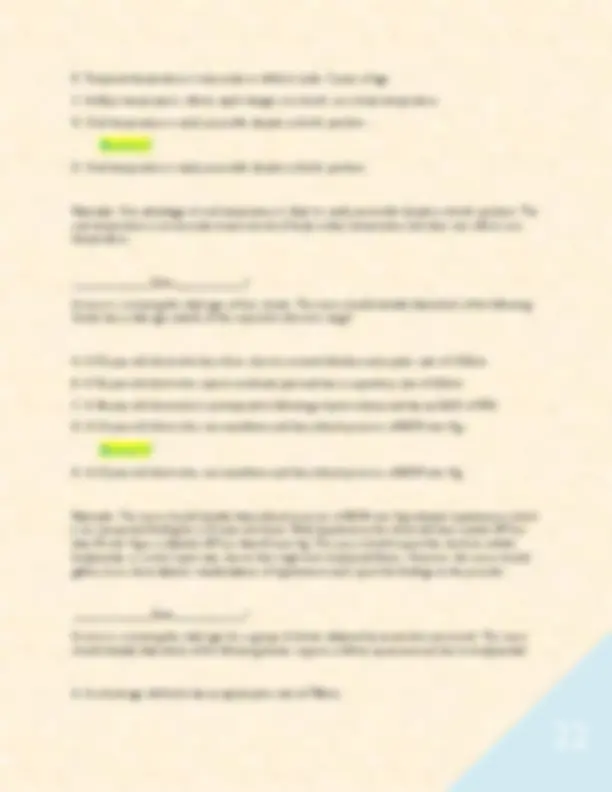
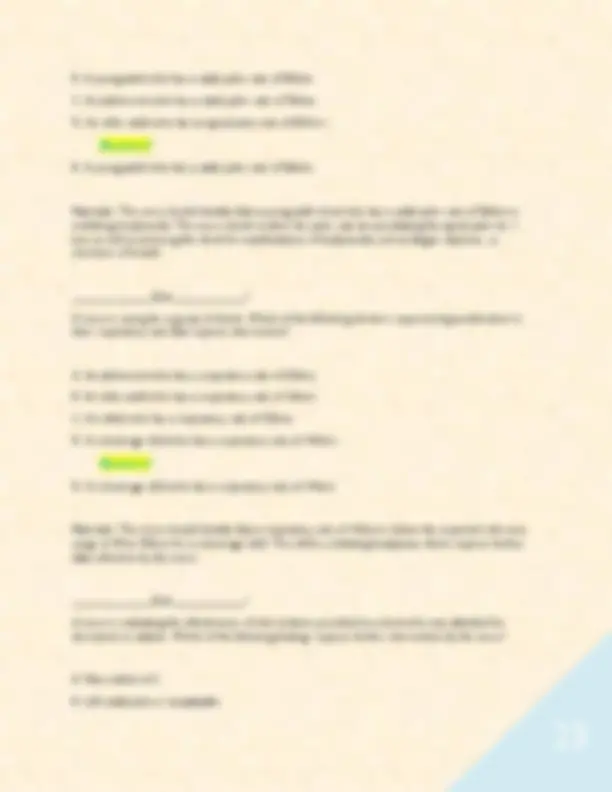
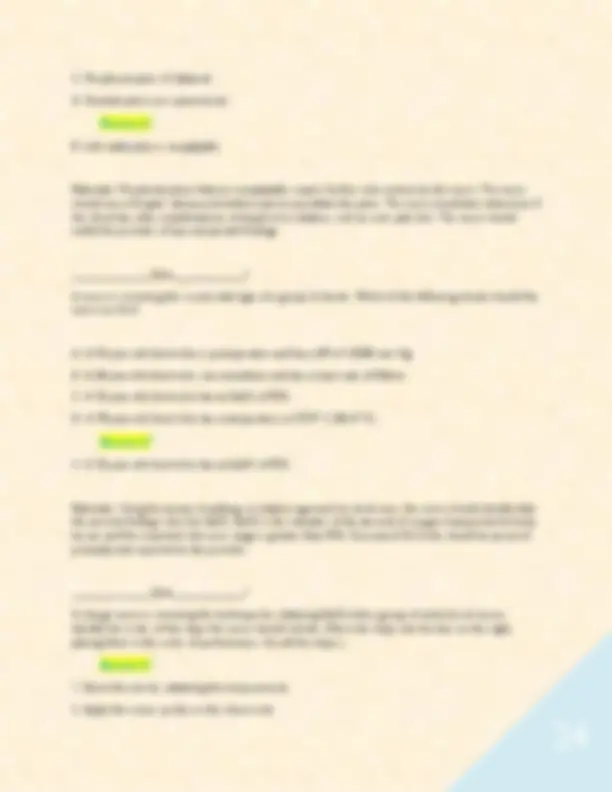
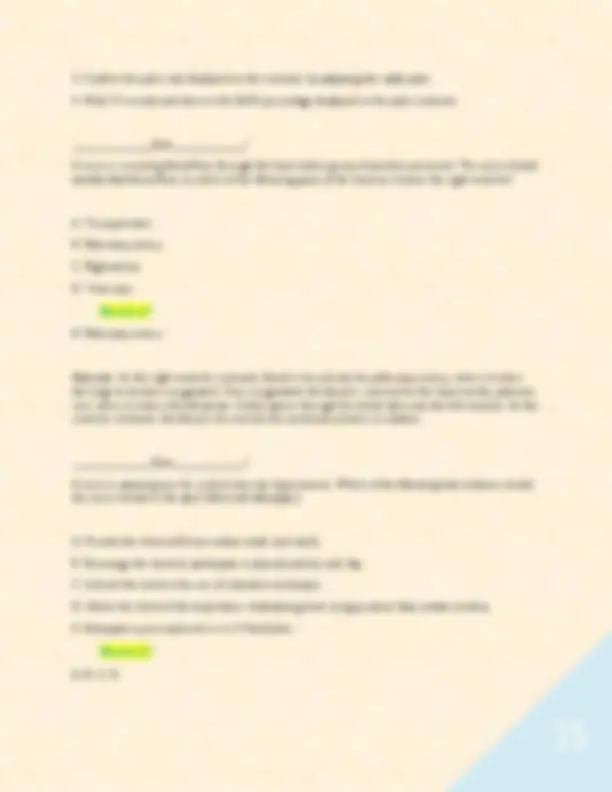
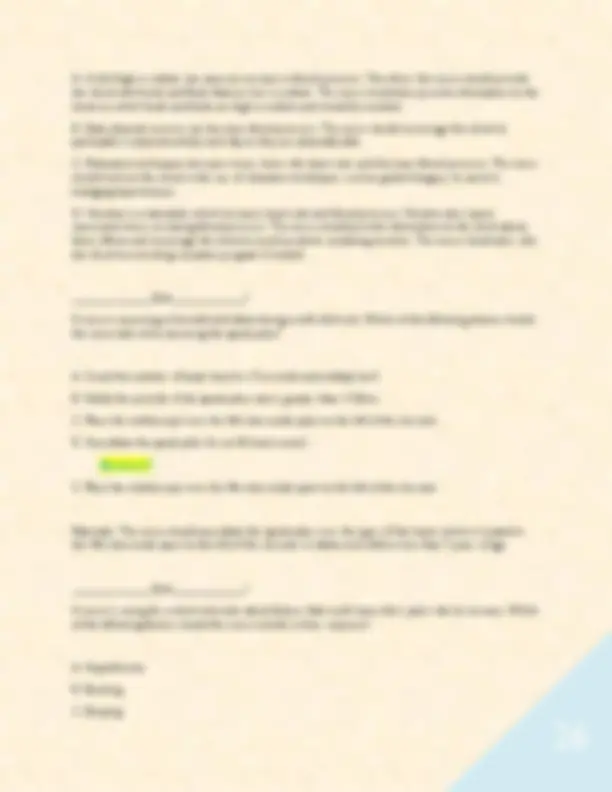
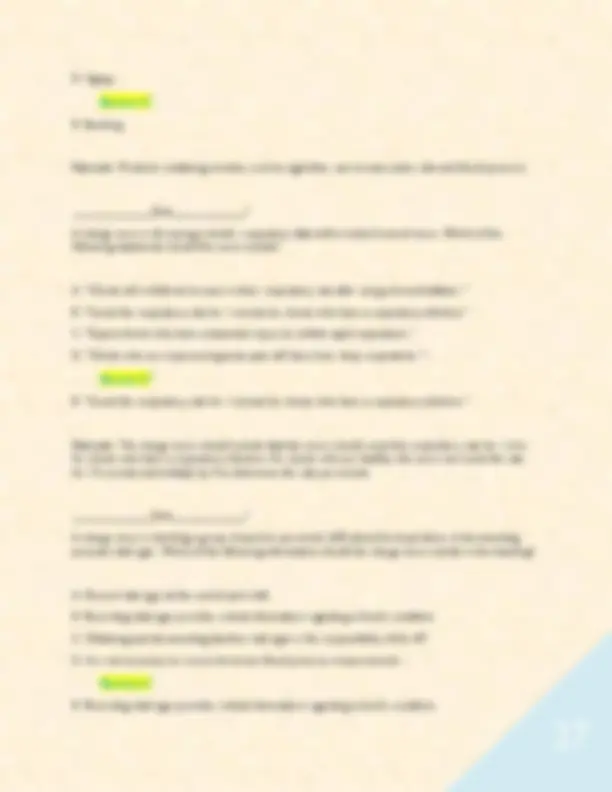
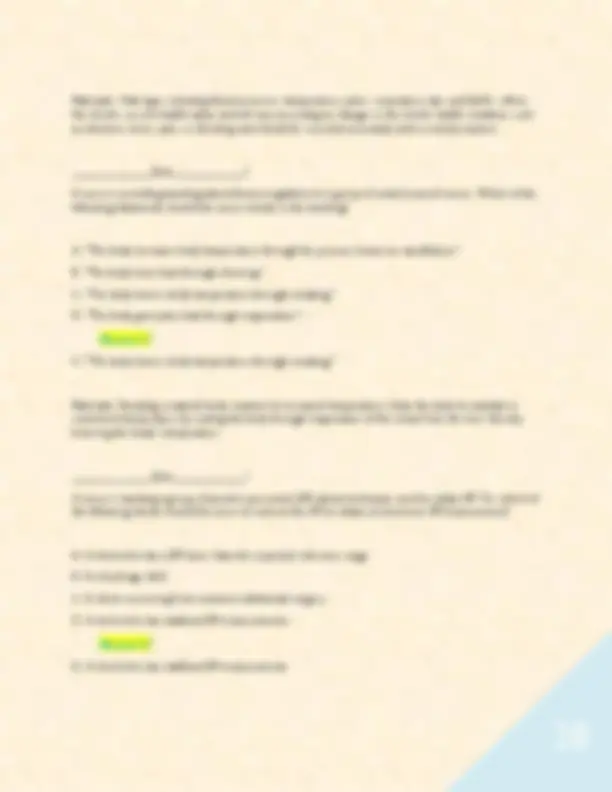
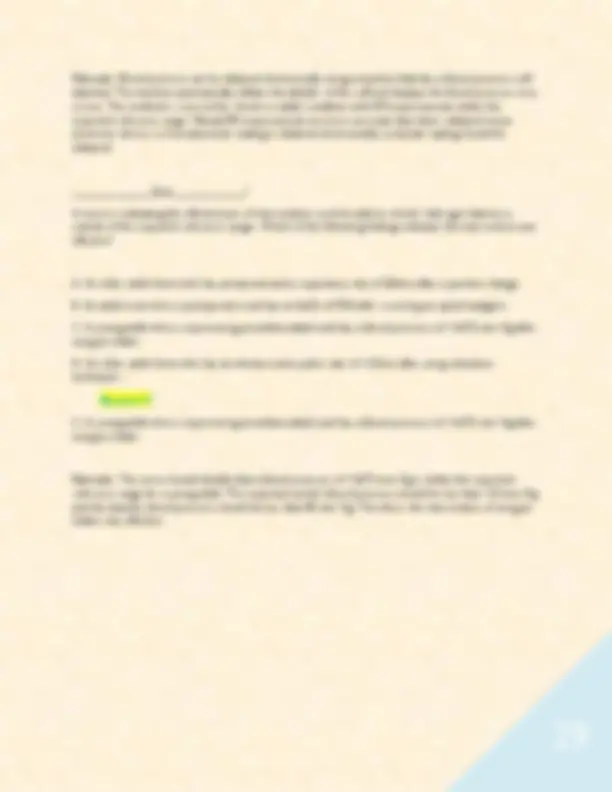


Study with the several resources on Docsity

Earn points by helping other students or get them with a premium plan


Prepare for your exams
Study with the several resources on Docsity

Earn points to download
Earn points by helping other students or get them with a premium plan
Community
Ask the community for help and clear up your study doubts
Discover the best universities in your country according to Docsity users
Free resources
Download our free guides on studying techniques, anxiety management strategies, and thesis advice from Docsity tutors
Engage Fundamentals RN: Vital Signs NUR 112 / NUR112 (UPDATE 2025/2026) Actual Exam Questions with Certified Solutions. Terms in this set (58) _____________Quiz____________? A nurse is evaluating the effectiveness of interventions provided to four clients who have unexpected findings for vital signs. Which of the following findings requires follow up? A. A client that has 8 mm Hg difference in systolic BP when moving from a sitting to a standing position. B. A client has a radial pulse of +4 bilateral. C. An older adult client has a tympanic temperature of 35.9 C (96.6 F). D. A newborn has a respiratory rate of 56/min while sleeping. - Answer✓✓ B. A client has a radial pulse of +4 bilateral. Rationale: A peripheral pulse strength of +4 is described as bounding and is considered an unexpected finding. The nurse should check further and report the findings to the provider. A pulse strength of +2 is considered an expected
Typology: Exams
1 / 29

This page cannot be seen from the preview
Don't miss anything!






















Terms in this set (58) _____________Quiz____________? A nurse is evaluating the effectiveness of interventions provided to four clients who have unexpected findings for vital signs. Which of the following findings requires follow up? A. A client that has 8 mm Hg difference in systolic BP when moving from a sitting to a standing position. B. A client has a radial pulse of +4 bilateral. C. An older adult client has a tympanic temperature of 35.9 C (96.6 F). D. A newborn has a respiratory rate of 56/min while sleeping. -
B. A client has a radial pulse of +4 bilateral. Rationale: A peripheral pulse strength of +4 is described as bounding and is considered an unexpected finding. The nurse should check further and report the findings to the provider. A pulse strength of +2 is considered an expected finding. _____________Quiz____________? A nurse is providing care to a client who has an apical pulse rate of 54/min and is experiencing dizziness. Which of the following is the nurse's priority action? A. Teach the client how to take their pulse so they can keep the provider informed of variations. B. Inform the client to ask for assistance with getting out of bed.
C. Educate the client on medications, including therapeutic effects and potential adverse effects. D. Ensure the client has been taking medications as prescribed. -
B. Inform the client to ask for assistance with getting out of bed. Rationale: Bradycardia associated with dizziness indicates the greatest risk to this client is injury due to a fall; therefore this is the priority action by the nurse. _____________Quiz____________? A nurse is preparing an in-service about factors affecting respiratory rate for a group of assistive personnel. Which of the following information should the nurse include? A. Anxiety can decrease a client's respiration rate. B. Opioid analgesics can increase a client's respiratory rate. C. Pain can decrease a client's respiratory rate. D. Fever can increase a client's respiratory rate. -
D. Fever can increase a client's respiratory rate. Rationale: The nurse should include that an increased body temperature can cause an increase in a client's respiratory rate. Other factors that can increase respiratory rates include physical exertion, chronic lung disease, and anxiety. _____________Quiz____________? A nurse is obtaining vital signs for a group of clients. Which of the following findings requires intervention? A. A 17-year-old who has a respiratory rate of 16/min. B. A young adult who has a pulse rate of 98/min. C. An 11-year-old child who has a respiratory rate of 34/min. D. An older adult who has a pulse rate of 62/min. -
Rationale: The nurse should identify that the apical pulse is auscultated over the apex of the client's heart for a client who is older than 7 years of age. This is located between the 5th intercostal space to the left of the client's sternum. _____________Quiz____________? A nurse is caring for a client who has an increase in cardiac output. Which of the following findings should the nurse expect? A. Increase in blood pressure. B. Decrease in respiratory rate. C. Decrease in heart rate. D. Increase in stroke volume. -
A. Increase in blood pressure Rationale: The nurse should identify that an increase in cardiac output causes an increase in the client's blood pressure. Cardiac output is the amount of blood pumped by the ventricles in 1 min. _____________Quiz____________? A nurse is caring for a client who has a heart rate of 120/min. Which of the following action should the nurse take? A. Instruct the client to bear down like they are having a bowel movement. B. Offer the client hot caffeinated tea to drink early in the morning. C. Hold the clients thyroid medication. D. Encourage the client to take a warm shower. -
A. Instruct the client to bear down like they are having a bowel movement.
Rationale: The Valsalva maneuver can be used to regulate heart rate. To elicit this, the nurse should instruct the client to "bear down" like they're having a bowel movement. This action produces a vasovagal response in the clients body, which lowers the client's heart rate. _____________Quiz____________? Charge nurse is discussing mechanisms of loss of body heat with a newly licensed nurse. Which of the following statements should the nurse include? A. "Convection is the loss of body heat when a client is in contact with the cooler surface." B. "Conduction is the loss of body heat when sweat dries from a client's skin." C. "Evaporation is the loss of body heat when a client is near a current of cool air." D. "Radiation is the loss of body heat when a client is in close proximity to a cooler surface." -
D. "Radiation is the loss of body heat when a client is in close proximity to a cooler surface." Rationale: The nurse should include that radiation is the loss of body heat that occurs when a client is in close proximity to a cooler surface. For example, radiative heat loss can occur when a client sits near a window when it is cold outside. _____________Quiz____________? The nurse is reviewing documentation of vital signs by a nearly licensed nurse for an assigned client. Which of the following entries in the chart requires follow up by the nurse? A. BP 130/82 mm Hg left arm, lying. Client reports experiencing postoperative pain as 7 on a scale of 0 to 10. Prescribed analgesic administered and will re-evaluate BP in 30 min. B. Pulse rate 116/min, left radial, standing, immediately following 10 min of ambulating in hall. C. saO2 93% left index finger, client, sleeping, nasal O2 dislodged. Nasal O2 readjusted and saO increased to 95%. D. Respiratory rate 18/min the observation, client sitting in chair. -
B. Pulse rate 116/min, left radial, standing, immediately following 10 min of ambulating in hall.
_____________Quiz____________? A nurse is evaluating the effectiveness of interventions used for clients who had alterations in vital signs. Which of the following clients' vital signs indicate that interventions were effective? (Select all that apply.) A. A preschooler who was exhibiting tachypnea 2 hr postoperative and now has a respiratory rate of 26/min B. An older adult client who had bradycardia while sleeping and now has an apical pulse rate of 66/min C. A young adult who had hypotension after receiving an opioid analgesic and now has a blood pressure of 98/68 mm Hg D. A toddler who was febrile 2 hr ago due to a viral infection and has a temporal temperature of 38.2° C (100.8° F) E. An adult client who had tachycardia 1 hr ago due to postoperative pain and has an apical pulse rate of 106/min -
Rationale: A- The nurse should identify that a respiratory rate of 26/min for a preschooler is within the expected reference range of 22 to 34/min. This finding indicates that interventions were effective. B- The nurse should identify that an apical pulse rate of 66/min is within the expected reference range of 60 to 100/min for an older adult client. This finding indicates that interventions were effective. C- The nurse should identify that hypotension is a blood pressure of less than 90/60 mm Hg. Therefore, a blood pressure of 98/68 mm Hg indicates that the client's blood pressure is no longer hypotensive, so interventions were effective. _____________Quiz____________? A nurse is observing an assistive personnel (AP) who is obtaining a blood pressure reading from a client. Which of the following actions by the AP requires follow up by the nurse? A. The AP uses a cuff width that is 40% of the circumference of the client's arm. B. The AP provides support for the client's arm while taking the BP. C. The AP waits to take the client's BP 45 min after the client ambulates in the hallway.
D. The AP loosens the valve to reduce pressure within the bladder cuff at a rate of 5 mm Hg per second. -
D. The AP loosens the valve to reduce pressure within the bladder cuff at a rate of 5 mm Hg per second. Rationale: Releasing the pressure at a rate of 5 mm Hg per second is too fast. The recommended rate is 2 mm Hg per second. Releasing the valve too quickly could prevent the AP from noting the correct reading and too slowly can cause additional discomfort to the client. _____________Quiz____________? A nurse is caring for a client who has a heart rate of 118/min. Which of the following actions should the nurse take to improve the client's heart rate? A. Encourage the client to reduce intake of caffeinated soft drinks. B. Inform the client to ambulate in the hallway for 10 min prior to taking vital signs. C. Increase the room temperature and add blankets to warm the client. D. Withhold the client's anti-anxiety medication. -
A. Encourage the client to reduce intake of caffeinated soft drinks. Rationale: In an adult client, a heart rate greater than 100/min is known as tachycardia. Tachycardia can be due to exercise, anxiety, certain medications, or use of caffeine or nicotine. It can also be caused by an abnormality in the electrical system of the heart. The nurse should encourage the client to limit their intake of caffeinated soft drinks to decrease the incidence of tachycardia. _____________Quiz____________? A charge nurse in a clinic is preparing an in-service about blood pressure measurements for a group of staff members. Which of the following information should the nurse include? A. A client is diagnosed with an elevated blood pressure when the measurement is greater than 130/ mm Hg. B. A client is experiencing a hypertensive crisis when their blood pressure is greater than 150/90 mm Hg.
C. "Cardiac output is the ability of the muscle fibers in the ventricles to stretch." D. "Cardiac output is the resistance of the ventricles to pump blood through the heart." -
"Cardiac output is the amount of blood flow through the heart in 1 minute." Rationale: The nurse should identify that cardiac output is the amount of blood pumped by the ventricles through the heart within 1 min. _____________Quiz____________? A charge nurse is evaluating a newly licensed nurse's documentation of vital signs for several clients. Which of the following documentation should the charge nurse identify as being incomplete? A. Radial pulse regular at 84/min B. Respirations observed as even, nonlabored at 20/min with client in supine position C. BP 124/82 mm Hg, lying in bed D. Temporal temperature 36.9° C (98.4° F) -
C. BP 124/82 mm Hg, lying in bed Rationale: The charge nurse should identify that this documentation is incomplete because it does not include the site from where the blood pressure was obtained. _____________Quiz____________? A nurse is reviewing the vital signs obtained by an assistive personnel at 1200. For which of the following clients should the nurse plan to intervene? A. Adult male who has a respiratory rate of 18/min B. Toddler who has a respiratory rate of 44/min C. Newborn who has a respiratory rate of 56/min D. Adolescent female who has a respiratory rate of 16/min -
B. Toddler who has a respiratory rate of 44/min Rationale: The expected reference range for respiratory rate in toddlers is 25 to 30/min, so this client will need to be assessed by the nurse, as they are exhibiting tachypnea. The nurse should reassess the vital signs to ensure previous readings were accurate and evaluate the client to determine a potential cause for the increased respiratory rate, such as anxiety, crying, or physical exertion. _____________Quiz____________? A nurse is discussing the use of a client's thigh for blood pressure measurements with an assistive personnel (AP). Which of the following information should the nurse include? A. Select a blood pressure cuff width that is 25% of the circumference of the client's thigh. B. Palpate the femoral pulse when obtaining blood pressure in the thigh. C. Expect blood pressure in the thigh to be 10 to 15 mm Hg less than in the arm. D. Use the thigh to obtain blood pressure when a client has severe edema in their arms. -
D. Use the thigh to obtain blood pressure when a client has severe edema in their arms. Rationale: The nurse should instruct the AP to obtain blood pressure measurements in the thigh when a client has severe edema in the arms or a shunt in place for dialysis. _____________Quiz____________? A nurse is planning care for a group of clients. For which of the following clients should the nurse direct an assistive personnel (AP) to obtain a rectal temperature? A. A toddler who has diarrhea B. A client who is 1 day postoperative following a hemorrhoidectomy and receiving pain medications via PCA pump C. An infant who is receiving intravenous fluids D. A client who is diaphoretic and frequently chewing ice to relieve dry mouth -
D. A client who is diaphoretic and frequently chewing ice to relieve dry mouth
Rationale: The nurse should identify that orthostatic hypotension is a drop in systolic pressure of at least 20 mm Hg, or a drop in diastolic pressure of at least 10 mm Hg, within 1 min of moving to a sitting or standing position after lying down. _____________Quiz____________? A nurse is reviewing the vital signs for a group of clients. Which of the following clients should the nurse identify as exhibiting tachycardia? A. An infant who has an apical pulse rate of 132/min B. A preschooler who has an apical pulse rate of 108/min C. A young adult who has an apical pulse rate of 104/min D. An older adult who has an apical pulse rate of 96/min -
C. A young adult who has an apical pulse rate of 104/min Rationale: The nurse should identify that a pulse rate of 104/min is above the expected reference range of 60 to 100/min for a young adult. Therefore, this client is exhibiting tachycardia. The nurse should allow the client to rest in a comfortable position and recheck the apical pulse rate. If it remains elevated, the nurse should notify the provider. _____________Quiz____________? A nurse is teaching a group of newly licensed nurses about vital sign measurements. Which of the following factors should the nurse include in the teaching? A. Anxiety can cause a decrease in respiratory rate. B. Body temperature is typically lower in older adults. C. Caffeine can cause a temporary decrease in pulse rate in adolescents. D. Blood pressure slightly decreases immediately following the use of nicotine. -
B. Body temperature is typically lower in older adults.
Rationale: The nurse should identify that body temperature is generally slightly lower in older adults than in younger adults and children. _____________Quiz____________? A nurse is preparing an in-service about peripheral pulses for a group of staff nurses. Which of the following information should the nurse include? A. A pulse strength of +4 indicates that the pulse is of normal strength upon palpation. B. A femoral pulse that is bounding upon palpation is an expected finding in a young adult. C. A pulse strength of +1 indicates that the pulse is weak or diminished upon palpation. D. A pedal pulse that is weak upon palpation is an expected finding in an older adult. -
C. A pulse strength of +1 indicates that the pulse is weak or diminished upon palpation. Rationale: The nurse should identify that a pulse strength of +1 indicates that the pulse is weak or diminished upon palpation. This is an expected finding and requires no further evaluation. _____________Quiz____________? A charge nurse is reviewing orthostatic hypotension with a group of newly licensed nurses. Which of the following statements should the charge nurse make? A. "The first step in checking for orthostatic hypotension is obtaining a client's blood pressure while they are standing." B. "An increase of 5 millimeters of mercury in the diastolic pressure with a position change indicates orthostatic hypotension." C. "A decrease of 20 millimeters of mercury in the systolic pressure with a position change indicates orthostatic hypotension." D. "Wait 5 minutes to check the client's blood pressure after each position change." -
C. "A decrease of 20 millimeters of mercury in the systolic pressure with a position change indicates orthostatic hypotension."
_____________Quiz____________? A nurse is planning care for a client who is experiencing tachycardia. Which of the following interventions should the nurse plan to include? A. Instruct the client to increase exercise. B. Instruct the client to consume no more than four caffeinated beverages per day. C. Encourage the client to practice relaxation techniques each day. D. Encourage the client to engage in pattern paced breathing by panting. -
C. Encourage the client to practice relaxation techniques each day. Rationale: Tachycardia can be caused by stress or anxiety. The nurse should encourage the client to participate in relaxation techniques such as guided imagery, meditation, or yoga, because these can decrease heart rate and blood pressure. _____________Quiz____________? A nurse is discussing the physiology of blood pressure with a group of assistive personnel. Which of the following information should the nurse include? A. Diastolic blood pressure reflects the pressure exerted during contraction of the heart. B. Blood pressure is measured and documented in millimeters of mercury. C. Blood pressure decreases when the blood viscosity increases. D. Systolic blood pressure reflects the pressure when the heart is relaxed. -
B. Blood pressure is measured and documented in millimeters of mercury. Rationale: Blood pressure is measured in millimeters of mercury (mm Hg) and is expressed as a fraction. The pressure is measured with a sphygmomanometer. _____________Quiz____________?
A charge nurse is reviewing the expected reference range of blood pressure in adult clients with a newly licensed nurse. Which of the following statements should the charge nurse include? A. "Hypertension is diagnosed with two elevated measurements on two separate occasions." B. "Successive blood pressure measurements of 126 over 78 is classified as stage I hypertension." C. "Stage II hypertension is diagnosed when the blood pressure measurement is 132 over 86." D. "A blood pressure measurement of 176 over 102 is classified as a hypertensive crisis." -
A. "Hypertension is diagnosed with two elevated measurements on two separate occasions." Rationale: A diagnosis of hypertension is not usually made based on a single elevated measurement; there are generally at least two elevated readings taken on two or more separate occasions for the provider to determine this diagnosis. _____________Quiz____________? A nurse is caring for a client who has an increase in cardiac afterload. Which of the following findings should the nurse expect? A. Increase in blood pressure B. Increase in respiratory rate C. Decrease in cardiac output D. Decrease in preload -
A. Increase in blood pressure Rationale: The nurse should identify that a client who has an increase in afterload increases the risk for hypertension. Afterload is the resistance of the ventricle to pump the heart muscle and eject blood into the client's bloodstream during systole. _____________Quiz____________? A nurse is reviewing the vital signs for a group of clients to determine the effectiveness of interventions. Which of the following findings indicates an intervention was effective?
A nurse is observing an assistive personnel (AP) obtain vital signs from an adult client. Which of the following actions by the AP requires follow up by the nurse? A. The AP pulls the pinna up and back when obtaining a tympanic temperature. B. The AP informs the client when they are counting the respirations. C. The AP gently presses down with the pads of two to three fingers over the radial pulse site. D. The AP selects a blood pressure cuff width that is 40% the circumference of the client's arm. -
B. The AP informs the client when they are counting the respirations. Rationale: According to evidence-based practice, the AP should not inform the client they are going to count their respirations. This action can lead the client to alter their breathing, which can cause inaccurate results. When obtaining vital signs, the AP should count a client's respirations when they are relaxed and at rest. _____________Quiz____________? A nurse is caring for a recently admitted client and as part of the plan of care, two nurses obtained simultaneous pulse rates. The client's auscultated apical pulse was 106/min and the palpated radial pulse was 93/min. The nurse should document the findings as which of the following? A. Pulse deficit less than 10 B. Radial pulse irregular C. Apical pulse greater than radial D. Pulse deficit of 13/min -
D. Pulse deficit of 13/min Rationale: A pulse deficit is the numerical difference between the apical pulse and a peripheral pulse (usually the radial) for 1 min time. This can be caused by atrial fibrillation, aortic rupture, or coronary artery disease. The nurse should document the findings in the client's medical record and notify the provider if a pulse deficit is present. _____________Quiz____________?
A nurse obtains a client's electronic blood pressure reading of 188/96 mm Hg. Which of the following actions should the nurse take next? A. Provide client teaching regarding medications to control blood pressure. B. Notify the provider of the client's blood pressure reading. C. Provide client education on measures to decrease blood pressure. D. Obtain a manual blood pressure reading from the client. -
D. Obtain a manual blood pressure reading from the client. Rationale: Evidence-based practice dictates that if a client's blood pressure is not within the expected reference range when it is taken with an electronic blood pressure machine, then the nurse should recheck the blood pressure by obtaining a manual blood pressure reading to ensure accuracy. _____________Quiz____________? A charge nurse is reviewing documentation of vital signs by a newly licensed nurse. Which of the following pieces of documentation is correct? A. Pulse 52/min B. Respiratory rate 24 C. SaO2 97% right index finger, room air D. Blood pressure 132/86 mm Hg -
C. SaO2 97% right index finger, room air Rationale: The charge nurse should identify that this documentation is thorough and complete and does not require any additional information. The information provided includes the measurement, the site used, and that the client is not on oxygen. _____________Quiz____________? A nurse is preparing an in-service for a group of newly hired assistive personnel (AP) about body temperature. Which of the following information should the nurse include?